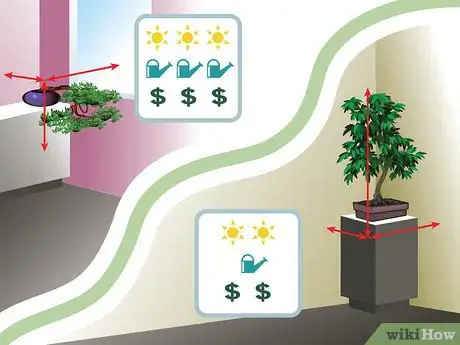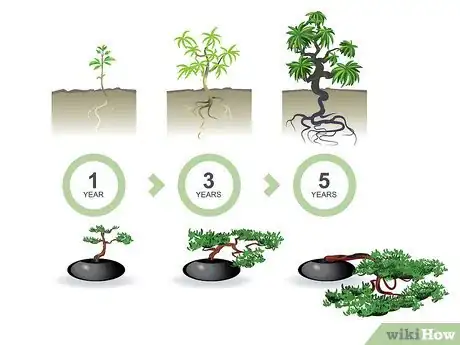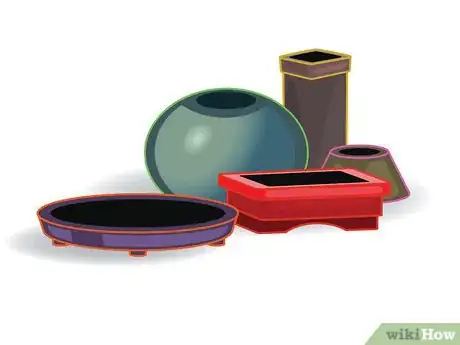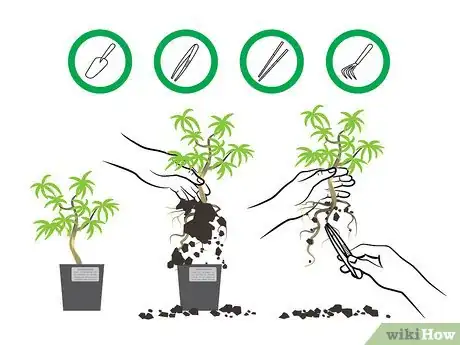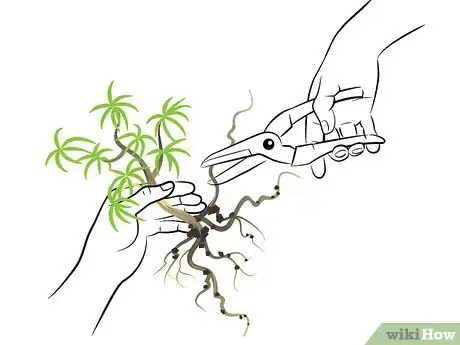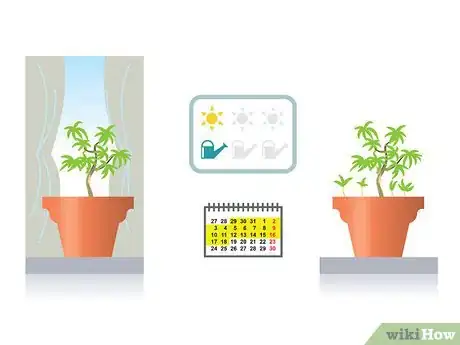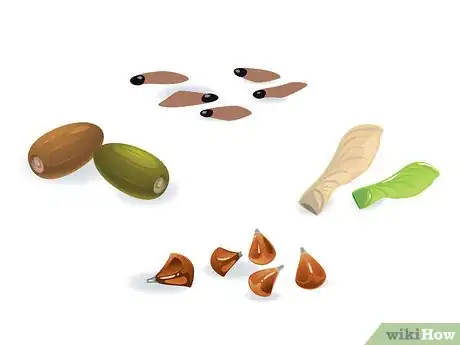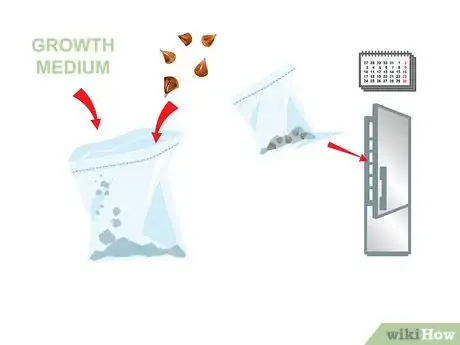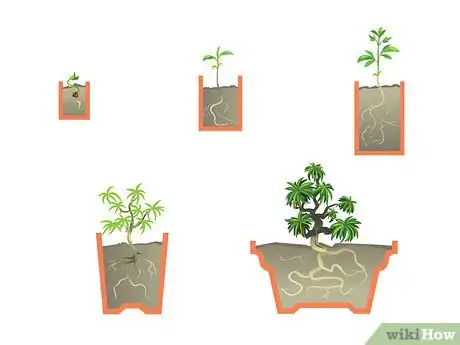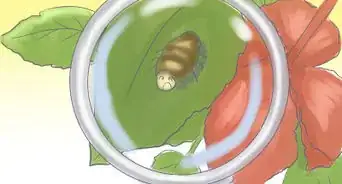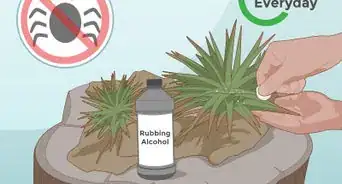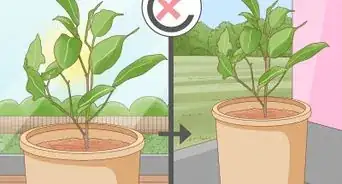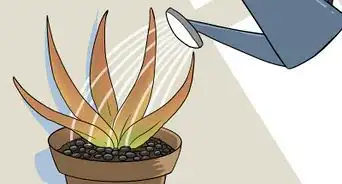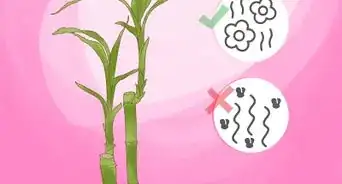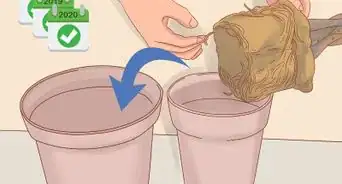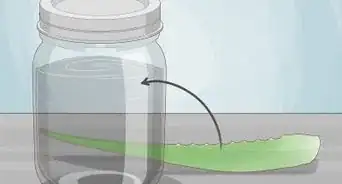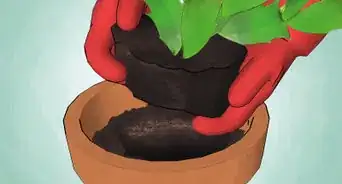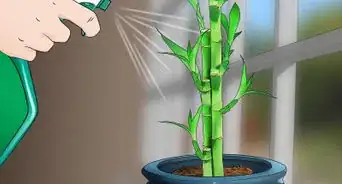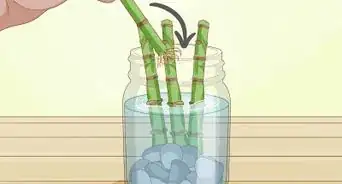This article was co-authored by Lauren Kurtz. Lauren Kurtz is a Naturalist and Horticultural Specialist. Lauren has worked for Aurora, Colorado managing the Water-Wise Garden at Aurora Municipal Center for the Water Conservation Department. She earned a BA in Environmental and Sustainability Studies from Western Michigan University in 2014.
wikiHow marks an article as reader-approved once it receives enough positive feedback. This article received 44 testimonials and 91% of readers who voted found it helpful, earning it our reader-approved status.
This article has been viewed 2,237,555 times.
The ancient art of growing Bonsai trees is well over a thousand years old. Many individuals are not aware that a simple potted plant is literally the meaning of Bonsai, "Potted Plant." There are however a large pool of types of plants, bushes and even trees that can be trained and kept as a Bonsai. Though usually associated with Japan, Bonsai tree cultivation actually originated in China, where the trees eventually came to be associated with the religion of Zen Buddhism. Bonsai trees are now used for decorative and recreational purposes in addition to their traditional uses. Caring for bonsai trees gives the cultivator a chance to take a contemplative yet creative role in the growth of an emblem of natural beauty.
Steps
Choosing the Right Bonsai Tree for You
-
1Select a suitable species of tree for your climate. Not all Bonsai trees are the same. Many woody perennials and even some tropical plants can be made into Bonsai trees, but not every species will be appropriate for your unique location. When selecting a species, it's important to consider the climate that the tree will be grown in. For instance, some trees die in freezing weather, while others actually require the temperature to drop below freezing so that they can enter a dormant state and prepare for the spring. Before starting a Bonsai tree, make sure the species you've chosen can live in your area - especially if you plan on having an outdoor tree. The staff at your local garden supply store will be able to help you if you're unsure.
- One particularly beginner-friendly variety of Bonsai tree is the juniper. These evergreens are hardy, surviving all across the northern hemisphere and even in the more temperate regions of the southern hemisphere. In addition, juniper trees are easy to raise - they respond well to pruning and other "training" efforts and, because they are evergreens, never lose their leaves. They are rather slow growing, however.
- Other conifers commonly cultivated as Bonsai trees include pines, spruces, and cedars of many varieties. Deciduous (leafy) trees are another possibility - Japanese maples are especially beautiful, as are magnolias, elms, and oaks. Finally, some non-woody tropical plants, like jade and "snowrose", are good choices for indoor environments in cool or temperate climates.
-
2Decide whether you plan on having an indoor or outdoor tree. The needs of indoor and outdoor Bonsai trees can vary drastically. Generally, indoor environments are drier and receive less light than outdoor environments, so you'll want to choose trees with lower light and moisture requirements. Below are listed some of the most common varieties of bonsai tree, grouped by their appropriateness for either indoor or outdoor environments:
- Indoor: Ficus, Hawaiian Umbrella, Serissa, Gardenia, Camellia, Kingsville Boxwood.
- Outdoor: Juniper, Cypress, Cedar, Maple, Birch, Beech, Ginkgo, Larch, Elm.
- Note that temperate species require winter dormancy or the tree will eventually die. They cannot be grown indoors for long periods of time.
Advertisement -
3Select the size of your bonsai. Bonsai trees come in a wide variety of sizes. Full-grown trees can be as small as 6 inches (15.2 cm) tall to as large 3 feet (0.9 m) tall, depending on their species. If you're choosing to grow your Bonsai tree from a seedling or a cutting from another tree, they can start off even smaller. Larger plants require more water, soil, and sunlight, so make sure that you have all the necessary amenities before making your purchase.
- Just a few things you'll want to consider when deciding on the size of your Bonsai tree:
- The size of the container you'll be using
- The space you have available at your home or office
- The availability of sunlight at your home or office
- The amount of care you'll be able to invest in your tree (larger trees take longer to prune)
- Just a few things you'll want to consider when deciding on the size of your Bonsai tree:
-
4Visualize the finished product while selecting a plant. Once you have decided which kind and what size of Bonsai you would like, you can go to a nursery or a bonsai shop and select the plant that will become your bonsai tree. When choosing a plant, look for a vibrant, healthy green leaf or needle color to make sure that the plant is healthy (however, keep in mind that deciduous trees can have different-colored leaves in the fall). Finally, when you've narrowed your search to the healthiest, prettiest plants, imagine what each plant will look like after it is pruned. Part of the fun of growing a bonsai tree is gently pruning and shaping it until it's exactly how you want it - this can take years. Pick a tree whose natural shape lends itself to the pruning and/or shaping plan you have in mind. (Many bonsai are made to look as if they were an adult tree, including proportion, shape, and foliage.)
- Note that if you choose to grow your Bonsai tree from a seed, you'll have the ability to control your tree's growth in nearly every stage of its development. However, it can take up to 5 years (depending on the species of tree) for a Bonsai tree to grow from a seed into a full-grown tree.[1] Because of this, if you're interested in pruning or shaping your tree immediately, you'll be better off buying a grown plant.
- Another option you have is to grow your Bonsai tree from a cutting. Cuttings are branches cut from growing trees and transplanted to new soil to start a separate (but genetically identical)[2] plant. Cuttings are a good compromise choice - they don't take as long to grow as seeds, but they still offer a good deal of control over the tree's growth.
-
5Select a pot. The hallmark feature of Bonsai trees is that they are planted in pots that restrict their growth. The most important factor in deciding which pot to use is to make sure the pot is large enough to allow enough soil to cover the roots of the plant. When you water your tree, it absorbs moisture from the soil through its roots. You do not want to have such a small amount of soil in the pot that the tree roots can not retain moisture. To prevent root rot, you'll also want to ensure your pot has one or more drainage holes on the bottom. If not, you can also drill these yourself.
- While your pot must be large enough to support your tree, you'll also want to maintain a neat, tidy aesthetic for your bonsai tree. Overly-large pots can dwarf the tree itself, giving a bizarre or mismatched appearance. Buy a pot big enough for the tree's roots, but not much bigger - the idea is for the pot to complement the tree aesthetically, but to be relatively unobtrusive visually.
- Some prefer to grow their Bonsai trees in plain, practical containers, then transfer them to prettier containers when they're full-grown. This is an especially useful process if your species of bonsai tree is a fragile one, as it allows you to put off the purchase of the "nice" pot until your tree is healthy and beautiful.
Potting Grown Trees
-
1Prepare the tree. If you've just bought a Bonsai from the store and it came in an unappealing plastic container or you've been growing your own Bonsai tree and finally want to put it in the perfect pot, you'll need to prepare it before transplanting it. First, ensure the tree has been pruned to the shape you desire. If you'd like the tree to grow a certain way after you re-pot it, wrap a sturdy wire around the tree or branch to gently direct its growth. You want your tree in tip-top shape before you transplant it to a new pot, which can be taxing for the plant.
- Know that trees with seasonal life cycles (for instance, many deciduous trees) are best transplanted in the spring. Rising temperatures in the spring cause many plants to enter a state of increased growth, which means they'll recover from pruning and root trimming faster.
- You may want to reduce watering before re-potting. Dry, loose soil can be much easier to work with than damp soil.
-
2Remove the tree and clean the roots. Carefully remove the plant from its current pot, making sure not to break or tear its main stem. You may want to use a potting shovel to help pry the plant out. Most of the roots will be cut before the plant is re-potted into the Bonsai pot. However, to have a clear view of the roots, it's usually necessary to brush away any of the dirt stuck to them. Clean the roots, brushing away any clumps of dirt obscuring your vision. Root rakes, chopsticks, tweezers, and similar tools are helpful for this process.
- The roots don't have to be spotless - just clean enough that you're able to see what you're doing while you prune them.
-
3Prune the roots. If their growth is not adequately controlled, bonsai trees can easily outgrow their containers. To ensure your bonsai tree remains manageable and tidy, prune its roots when you pot it. Cut any large, thick roots and any upward-facing roots, leaving a network of long, slender roots that will sit near the surface of the soil. Water is absorbed from the root tips, so, in a small container, many thin root strands are generally better than a single large, deep one.
-
4Prepare the pot. Before placing the tree in the pot, ensure it has a base of fresh, new soil to sit on that gives it the desired height. At the bottom of your empty pot, add a layer of coarse-grain soil as a base. Then, add a finer, looser growing medium or soil above this. Use a soil or medium that drains well - regular garden soil can hold too much water and may drown the roots. Leave a small amount of space at the top of your pot so that you can cover your tree's roots.
- If your plant comes with a recommended soil texture, it will do best in that kind of soil.
-
5Pot the tree. Position the tree in your new pot in the desired orientation. Finish adding your fine, well-draining soil or growing medium to the pot, making sure to cover the tree's root system. If desired, you may add a final layer of moss or gravel. In addition to being aesthetically pleasing, this can help hold the tree in place.
- If your tree isn't staying upright in your new pot, run a heavy gauge wire from the bottom of the pot through the drainage holes on the bottom of the pot. Tie the wire around the root system in order to hold the plant in place.
- You may want to install mesh screens over the pot's drainage holes to prevent soil erosion, which occurs when water carries soil out of the pot via the drainage holes.
-
6Care for your new bonsai tree. Your new tree has just undergone a radical, somewhat traumatic process. For 2-3 weeks after re-potting your tree, leave it in a semi-shaded area, protected from the wind or harsh, direct sunlight. Water the plant, but don't use fertilizer until the roots have re-established themselves. By giving your tree a "breather" after re-potting, you allow it to adapt to its new home, and, in time, thrive.
- As noted above, deciduous trees with yearly life cycles experience a period of intensified growth in the spring. Because of this, it's best to re-pot deciduous trees in the spring after their winter dormancy has ended. If your deciduous tree is an indoor plant, after allowing it to take root following a re-potting, you may want to move it outside where the rising temperature and increased sunlight can trigger its natural "growth spurt."
- When your bonsai tree is established, you may want to experiment with adding other small plants to its pot. If carefully arranged and maintained (like your tree), these additions can allow you to craft a perfectly pleasing tableau. Try using plants that are native to the same area as your bonsai tree so that one water and light regimen will support all the plants in the pot equally well.
Starting a Tree from Seed
-
1Obtain your seeds. Growing a bonsai tree from a single seed is an extremely long and slow process. Depending on the type of tree you grow, it can take up to 4-5 years for the tree's trunk to become just 1 inch (2.5 cm) in diameter.[3] Some seeds also require precisely controlled conditions for germination. However, this method is also perhaps the ultimate bonsai tree experience insofar as it allows you to have total control over the plant's growth from the moment it breaks through the soil. To start, buy seeds of your desired species of tree from a gardening store or gather them in nature.
- Many deciduous trees, like oaks, beeches, and maples, have instantly-recognizable seed pods (acorns, etc.) that release from the tree on a yearly basis. Because of the ease of obtaining their seeds, these types of trees make great choices if you're aiming to grow a bonsai tree from the seed.
- Try to get fresh seeds. The time window in which tree seeds can germinate is often smaller than that of flower or vegetable seeds. For instance, oak seeds (acorns) are "freshest" when they're harvested in early autumn and they retain some of their green color.[4]
-
2Allow the seed to germinate. Once you have gathered suitable seeds for your bonsai tree, you must care for them to ensure they germinate (sprout). In non-tropical areas with defined seasons, seeds usually fall from trees in autumn, then lie dormant through the winter before sprouting in spring. Seeds from trees that are native to these areas are usually biologically coded to germinate only after they experience the cold temperatures of winter and the gradually increasing warmth of spring. In these cases, it's necessary to either expose your seed to these conditions or to simulate them in your refrigerator.
- If you live in a temperate environment with defined seasons, you can simply bury your tree's seed in a small pot full of soil and keep it outside throughout the winter and into the spring. If you don't, you can keep your seeds in a refrigerator for the winter. Put your seeds in a plastic zip-lock bag with a loose, dampened growth medium (for example, vermiculite) and take them out in the spring when you see sprouts emerging.
- To simulate the natural cycle of gradually decreasing, then increasing temperature that takes place from the late autumn to early spring, place your bag of seeds at the bottom of the refrigerator initially. Over the next two weeks, gradually move it up, shelf by shelf, until it's at the top, right next to the cooling unit. Then, at the end of winter, reverse the process, moving the bag down shelf-by-shelf.[5]
- If you live in a temperate environment with defined seasons, you can simply bury your tree's seed in a small pot full of soil and keep it outside throughout the winter and into the spring. If you don't, you can keep your seeds in a refrigerator for the winter. Put your seeds in a plastic zip-lock bag with a loose, dampened growth medium (for example, vermiculite) and take them out in the spring when you see sprouts emerging.
-
3Introduce your seedlings to a seed tray or pot. When your seedlings have begun to sprout, you're ready to begin nurturing them in a small soil-filled container of your choosing. If you allowed your seeds to naturally germinate outdoors, they can generally remain in the pot that you germinated them in. If not, transfer your healthy seeds from the refrigerator to a pre-filled pot or seed tray. Dig a small hole for your seed and bury it so that its main sprout points up and its taproot points down. Immediately water your seed. Over time, try to keep the soil around the seed damp, but not sopping wet or mud-like, as this can cause the plant to rot.
- Don't use fertilizer until about 5 or 6 weeks after the plants have established themselves in their new containers. Start small, using only very minor amounts of fertilizer, or you may "burn" the plant's young roots, damaging them with overexposure to the chemicals in the fertilizer.
-
4Keep your seedlings in an area of suitable temperature. As your seeds continue to grow, it's important not to expose them directly to cold temperatures or you'll risk losing your young plants. If you live in an area with a warm spring, you may cautiously introduce your new seedlings to a warm but sheltered spot outdoors, ensuring your trees aren't exposed to harsh wind or constant sunlight, provided your species of tree is one that can naturally survive in your geographical area. If you're growing tropical plants or germinating your seeds out of season, however, you may find that it's better to keep your plants indoors or in a greenhouse where it's warmer.
- Regardless of where you keep your young seedlings, it's important to ensure they receive frequent, but not excessive watering. Keep the soil damp, but not soggy.
-
5Care for your young seedlings. Carry on with your regimen of watering and cautious sun exposure as your seedling grows. Deciduous trees will sprout two small leaves called cotyledons[6] directly from the seed before developing true leaves and continuing to grow. As your tree grows (again, usually this process takes years) you may gradually introduce it to larger and larger containers to accommodate its growth until it reaches the size that you'd like for your bonsai tree.
- Once your tree is fairly established, you can leave it outdoors in a spot where it receives morning sun and afternoon shade, provided that your species of tree is one that can naturally survive in your geographical location. Tropical plants and other fragile bonsai varieties may need to be kept indoors perpetually if your local climate isn't suitable.
Expert Q&A
Did you know you can get premium answers for this article?
Unlock premium answers by supporting wikiHow
-
QuestionWhat kind of soil should I use to plant a bonsai? Will it grow indoors?
 Lauren KurtzLauren Kurtz is a Naturalist and Horticultural Specialist. Lauren has worked for Aurora, Colorado managing the Water-Wise Garden at Aurora Municipal Center for the Water Conservation Department. She earned a BA in Environmental and Sustainability Studies from Western Michigan University in 2014.
Lauren KurtzLauren Kurtz is a Naturalist and Horticultural Specialist. Lauren has worked for Aurora, Colorado managing the Water-Wise Garden at Aurora Municipal Center for the Water Conservation Department. She earned a BA in Environmental and Sustainability Studies from Western Michigan University in 2014.
Professional Gardener You should use a soil that is appropriate for the plant you are trying to grow. Some plants will prefer a sandy soil, while others will like more of a loam. Always use well draining soil. Some bonsai plants will be able to grow indoors. It depends on the indoor environment (sun exposure, humidity, temperature, etc). Ficus, Hawaiian Umbrella, Serissa, Gardenia, Camellia, Kingsville Boxwood are all bonsais you can try to grow indoors.
You should use a soil that is appropriate for the plant you are trying to grow. Some plants will prefer a sandy soil, while others will like more of a loam. Always use well draining soil. Some bonsai plants will be able to grow indoors. It depends on the indoor environment (sun exposure, humidity, temperature, etc). Ficus, Hawaiian Umbrella, Serissa, Gardenia, Camellia, Kingsville Boxwood are all bonsais you can try to grow indoors. -
QuestionWhat's the best time of year to take a cutting?
 Lauren KurtzLauren Kurtz is a Naturalist and Horticultural Specialist. Lauren has worked for Aurora, Colorado managing the Water-Wise Garden at Aurora Municipal Center for the Water Conservation Department. She earned a BA in Environmental and Sustainability Studies from Western Michigan University in 2014.
Lauren KurtzLauren Kurtz is a Naturalist and Horticultural Specialist. Lauren has worked for Aurora, Colorado managing the Water-Wise Garden at Aurora Municipal Center for the Water Conservation Department. She earned a BA in Environmental and Sustainability Studies from Western Michigan University in 2014.
Professional Gardener
-
QuestionCan I grow a bonsai tree inside my room?
 wikiHow Staff EditorThis answer was written by one of our trained team of researchers who validated it for accuracy and comprehensiveness.
wikiHow Staff EditorThis answer was written by one of our trained team of researchers who validated it for accuracy and comprehensiveness.
Staff Answer wikiHow Staff EditorStaff Answer
wikiHow Staff EditorStaff Answer
References
- ↑ https://www.bonsaiempire.com/basics/cultivation/from-seeds
- ↑ https://www.bonsaiempire.com/basics/cultivation/from-cuttings
- ↑ http://www.bonsai4me.com/Basics/Basics_Seeds.html
- ↑ http://phytosphere.com/oakplanting/acorns.htm
- ↑ http://www.bonsai4me.com/Basics/Basics_Seeds.html
- ↑ http://www.bonsai4me.com/Basics/Basics_Seeds page 2.html
About This Article
To start a bonsai tree, you'll need a juvenile plant that you’d like to turn into a bonsai. You can actually make any woody plant into a bonsai tree, but popular options include juniper, ficus, fig, Japanese maple, Chinese elm, and jade. Get a pot for your bonsai that’s small enough to contain the juvenile plant without giving it much space to grow. Fill the container part way with a soil mix designed for the specific plant you've chosen. Then, prune the plant's roots halfway back to curb future growth. Set the plant in the container and fill in the remaining space with the soil mix, using a chopstick to push the root ball all the way to the bottom of the soil if necessary. Keeping the roots short and the root ball compacted near the base of the container will stunt the growth of the plant so it stays small. To shape your bonsai tree, wrap wire around the branches in loose coils and extend the coils past the end of each branch in the direction you want it to grow. Prune your bonsai tree whenever it starts growing too fast or gets bigger than you'd prefer. With a small container and some regular pruning, you'll be able to keep your plant dwarf-sized. For tips on growing a bonsai tree some seed from our Horticulture reviewer, keep reading!


